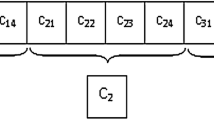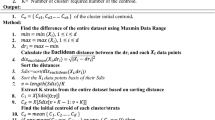Abstract
Clustering using K-means algorithm is very common way to understand and analyze the obtained output data. This clustering is done by making a sample collection of similar objects in one slot and non-similar objects in another slot. The slot can have say let N number of data objects and say let K number of clusters (slot) are formed to make a bunch of common data where k < n. Each cluster has its own centroid, but we cannot predict how exactly cluster shall be based on data. Cluster formation has random occurence, i.e., if one object is dissimilar from rest of all other cluster objects, then the dissimilar object must have its own cluster. This is the main drawback of this approach, and we cannot get optimal result from this clustering approach. To overcome the drawback challenge, we are proposing a formula to find the clusters at the run time, so this approach can give us optimal results. The proposed approach uses Euclidian distance formula as well Mehlanobis to find the minimum distance between slots as technically we called as clusters, and we have also applied the same approach to ant colony optimization (ACO) algorithm which results in the production of two- and multi-dimensional matrix.
Access this chapter
Tax calculation will be finalised at checkout
Purchases are for personal use only
Similar content being viewed by others
References
Wang, X., Jiao, Y., Fei, S.: Estimation of clusters number and initial centers of K-means algorithm using watershed method. In: 2015 14th International Symposium on Distributed Computing and Applications for Business Engineering and Science
Blum, C., Sampels, M.: Ant colony optimization for FOP shop scheduling: a case study on different pheromone representations. In: Proceedings of the 2002 Congress on Evolutionary Computation (CEC’02), vol. 2, pp. 1558–1563. IEEE Computer Society Press, Los Alamitos, CA (2002)
Zhang, Y., Xu, X., Liu, Y., Li, X., Ye, Y.: An agglomerative fuzzy K-means approach to building decision cluster classifiers. In: 2011 Second International Conference on Innovations in Bio-inspired Computing and Applications
Qi, J., Yu, Y., Wang, L., Liu, J.: K-means: an effective and efficient K-means clustering algorithm. In: 2016 IEEE International Conferences on Big Data and Cloud Computing (BDCloud), Social Computing and Networking, (SocialCom), Sustainable Computing and Communications (SustainCom)
Kane, A., Determining the number of clusters for a K-means clustering algortihm. Indian J. Comput. Sci. Eng. (IJCSE)
Dorigo, M., Birattari, M., Stitzle, T.: Ant colony optimization: artificial ants as a computational intelligence technique. IEEE Comput. Intell. Mag. (2006)
Tang, R., Fong, S., Yang, X.-S., Deb, S.: Integrating nature-inspired optimization algorithms to K-means clustering
Dubey, A., Choubey, A.: A systematic review on K-means clustering techniques. Int. J. Sci. Res. Eng. Technol. (IJSRET) 6(6) (2017). ISSN 2278-0882
Handhayani, T., Wasito, I.: Fully unsupervised clustering in nonlinearly separable data using intelligent kernel K-means. In: ICACSIS 2014. ©2014 IEEE, 978-1-4799-8075-8/14/$31.00
Sun, Y., Liu, G., Xu, K., A k-means-based projected clustering algorithm. In: 2010 Third International Joint Conference on Computational Science and Optimization
Tang, R., Fong, S., Yang, X.-S., Deb, S.: Integrating nature-inspired optimization algorithms to K-means clustering. © 2012 IEEE, 978-1-4673-2430-4/12/$31.00
Blum, C., Sampels, M.: An ant colony optimization algorithm for shop scheduling problems. J. Math. Model. Alg. 3(3), 285–308 (2004)
Blum, C., Sampels, M.: When model bias is stronger than selection pressure. In: Merelo Guervos, J.J., et al. (eds.) Proceedings of the PPSN-VII, Seventh International Conference on Parallel Problem Solving from Nature. Lecture Notes in Computer Science, vol. 2439, pp. 893–902. Springer, Berlin, Germany (2002)
Khadem, A., Nezhad, E.F., Sharifi, M.: Data mining: methods and utilities. Researcher 5(12), 47–59 (2013). ISSN: 1553-9865
Ghosh, S., Dubey, S.K.: Comparative analysis of K-means and fuzzy C-means algorithms. Int. J. Adv. Comput. Sci. Appl. 4(4) (2013)
Sun, H., Wang, S., Jiang, Q.: Fcm-based model selection algorithms for determining the number of clusters. Pattern Recognit. 37(10), 2027–2037 (2004)
Li, M., Ng, M., Cheung, Y., Huang, J.: Agglomerative fuzzy k-means clustering algorithm with selection of number of clusters. TKDE 20(11), 1519–1534 (2008)
Author information
Authors and Affiliations
Corresponding author
Editor information
Editors and Affiliations
Rights and permissions
Copyright information
© 2021 The Editor(s) (if applicable) and The Author(s), under exclusive license to Springer Nature Singapore Pte Ltd.
About this paper
Cite this paper
Yadav, K., Gupta, S., Gupta, N., Gupta, S.L., Khandelwal, G. (2021). Hybridization of K-means Clustering Using Different Distance Function to Find the Distance Among Dataset. In: Senjyu, T., Mahalle, P.N., Perumal, T., Joshi, A. (eds) Information and Communication Technology for Intelligent Systems. ICTIS 2020. Smart Innovation, Systems and Technologies, vol 195. Springer, Singapore. https://doi.org/10.1007/978-981-15-7078-0_29
Download citation
DOI: https://doi.org/10.1007/978-981-15-7078-0_29
Published:
Publisher Name: Springer, Singapore
Print ISBN: 978-981-15-7077-3
Online ISBN: 978-981-15-7078-0
eBook Packages: Intelligent Technologies and RoboticsIntelligent Technologies and Robotics (R0)




